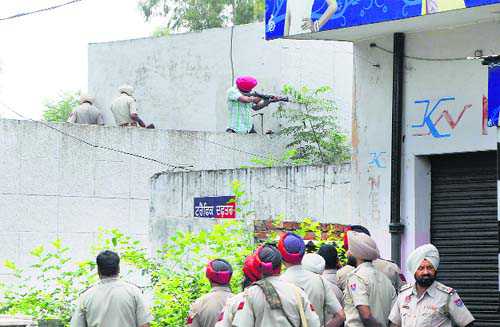
Gurdaspur seems to be a game plan that did not work.
Sandeep Dikshit
Can we be tempted into believing that Pakistan gave the game away about its involvement in the Gurdaspur police station siege? For want of familiar evidence such as intercepted communications chatter, corroboration is possible from two official e-mails sent by two wings of the Pakistani state, often at odds with each other's designs.
At 9 pm Monday night, a Pakistan Foreign Ministry issued a press release. It condemned the Gurdaspur attack in the “strongest terms” and “reiterated” its “condemnation of terrorism in all its manifestations and forms”. The release made no reference to the need to hold talks on Kashmir or to Islamabad's oft repeated complaint of increase in intensity of firing from the Indian side of the border.
The e-mail indicated that the “Spirit of Ufa” was tenuously holding. On a day when it would have been more prudent to keep its counsel, Pakistan’s civilian wing was upfront in trying to uphold the resolve by Prime Ministers Narendra Modi and Nawaz Sharif to create an opening for discussions on issues that have kept the two nations in a state of unsociability since Mumbai 2008. The Pakistan Foreign Office's unequivocal censure of the Gurdaspur attack showed one wing of the State among its many free-willed horses was not ready to countenance the gunning down of civilians in Gurdaspur.
Monday, 10 PM: The pitch was seemingly queered. Mail boxes again pinged, this time it was the Rawalpindi headquarters of the Pakistan Army. The Inter-Services Public Relations (ISPR), a combined publicity department of the three services, had sent a longish mail, along with six photographs. It began with a tirade about “a sudden spike in terms of intensity, caliber escalation [use of heavier and more lethal weapons] and air space violation by India” along the line of control (LoC) and the international boundary. Most of the press release and the six photographs were about a drone shot down on the Pakistan side of the border five days after Modi and Sharif met in Ufa on July 10. ISPR claimed the photos proved India had launched the drone into Pakistan.
It is not germane whether Pakistan's Inter-Services Intelligence (ISI) was trying to accuse India of border transgression. It is not relevant whether it was an attempt to even the score after the casualties in Gurdaspur were insufficient to compel a retaliatory action from the Indian Government. The social media, a tool utilised to maximum effect by Modi before and after last year’s general election, is convinced of a Pakistani hand and is seeking retaliation.
Both sides need to realise they have very little margin for error. In Pakistan, Nawaz is witnessing a rare sunny spell of governance. The armed forces have sequestered the Pakistan Taliban to their mountainous hideouts in the narrow strip bordering Afghanistan, incapable of mega violence in the heartland and just about capable enough to execute an intermittent Peshawar school attack in the nearby lowland. The Afghan Taliban is finally negotiating with Kabul. Central Asian energy seems more accessible with Pakistan joining the Shanghai Cooperation Organisation and China planning an economic belt running across the length of the country. Any heavy handed reprisal by India will unstitch this patchwork of favourable convergence.
The Modi government is unlike the previous United Progressive Alliance government. It may not be inclined to reflect on the long-term impact of trying to critically hurt Pakistan. Gurdaspur seems to be a gameplan that did not work out because the Punjab Roadways bus didn't stop and the railway bridge could not be blown up. Modi will be under pressure to demonstrate the muscularity against Pakistan. It was a promise he made while harvesting votes last year.
India's managers believe it will soon breach the below 10 per cent economic growth ceiling imposed by the 2008 world economic crises and the continuing slump. And India needs a favourable and peaceful neighbourhood. Post-Gurdaspur, foreign news agencies and reports are already raising the flag about India's ability to soak up a terrorist attack that might look like a cross-border strike. Most reports about Gurdaspur were factually accurate but headlines and commentaries were not. The banner heading of the Reuters report was: “Nuclear armed India and Pakistan on the edge after 12-hour gun-battle”. This is indicative of the developed world's perception of the tolerance threshold of the current lot of Indian policymakers. It may not be helpful in attracting quality and durable funds that can withstand the current global recession.
As Prime Minister, Modi has almost been statesman-like on his overseas tours. His declarations about Islam’s peaceful core and the requirement of a peaceful neighbourhood have astonished his domestic opponents who felt the pre-election Modi will transit into a confrontational Prime Minister. If the provocation is grave enough, he might risk global isolation and carry out a military escapade in Pakistan. The Myanmar cross border strike must have educated the Government about the downside of such an escapade without the approval of rulers on the other side. Myanmar has moved an army division to close the gap where the Indian army made its foray. That has made informal snatching of an odd rebel or inserting an informant, as in the past, unfeasible. India could pull off this caper in Myanmar because in the past, it withstood western pressure to stand by its military regime. There is a great degree of civility in bilateral ties. With Pakistan the consequences can be worse.
The responses so far from the two national capitals to the Gurdaspur assault have been controlled. South Block in New Delhi seems to have taken the ISPR litany in its stride. Nawaz knows the spy drone foray is a non-issue. The National Security Advisers are the best placed to assess to what extent both countries can avoid a mutually bruising entanglement. Both New Delhi and Islamabad have to exhaust diplomacy's potential.



























